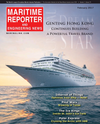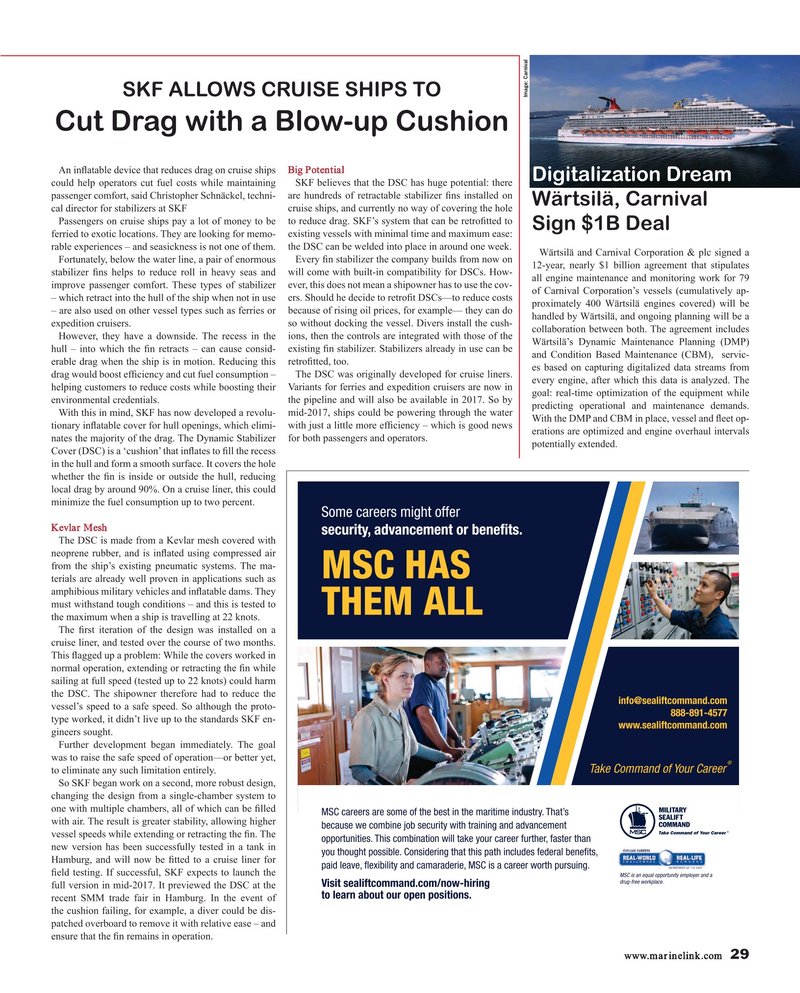
Page 29: of Maritime Reporter Magazine (February 2017)
The Cruise Industry Edition
Read this page in Pdf, Flash or Html5 edition of February 2017 Maritime Reporter Magazine
SKF ALLOWS CRUISE SHIPS TO
Image: Carnival
Cut Drag with a Blow-up Cushion
An in? atable device that reduces drag on cruise ships Big Potential
Digitalization Dream could help operators cut fuel costs while maintaining SKF believes that the DSC has huge potential: there passenger comfort, said Christopher Schnäckel, techni- are hundreds of retractable stabilizer ? ns installed on
Wärtsilä, Carnival cal director for stabilizers at SKF cruise ships, and currently no way of covering the hole
Passengers on cruise ships pay a lot of money to be to reduce drag. SKF’s system that can be retro? tted to
Sign $1B Deal ferried to exotic locations. They are looking for memo- existing vessels with minimal time and maximum ease: rable experiences – and seasickness is not one of them. the DSC can be welded into place in around one week.
Wärtsilä and Carnival Corporation & plc signed a
Fortunately, below the water line, a pair of enormous Every ? n stabilizer the company builds from now on 12-year, nearly $1 billion agreement that stipulates stabilizer ? ns helps to reduce roll in heavy seas and will come with built-in compatibility for DSCs. How- all engine maintenance and monitoring work for 79 improve passenger comfort. These types of stabilizer ever, this does not mean a shipowner has to use the cov- of Carnival Corporation’s vessels (cumulatively ap- – which retract into the hull of the ship when not in use ers. Should he decide to retro? t DSCs—to reduce costs proximately 400 Wärtsilä engines covered) will be – are also used on other vessel types such as ferries or because of rising oil prices, for example— they can do handled by Wärtsilä, and ongoing planning will be a expedition cruisers. so without docking the vessel. Divers install the cush- collaboration between both. The agreement includes
However, they have a downside. The recess in the ions, then the controls are integrated with those of the
Wärtsilä’s Dynamic Maintenance Planning (DMP) hull – into which the ? n retracts – can cause consid- existing ? n stabilizer. Stabilizers already in use can be and Condition Based Maintenance (CBM), servic- erable drag when the ship is in motion. Reducing this retro? tted, too.
es based on capturing digitalized data streams from drag would boost ef? ciency and cut fuel consumption – The DSC was originally developed for cruise liners. every engine, after which this data is analyzed. The helping customers to reduce costs while boosting their Variants for ferries and expedition cruisers are now in goal: real-time optimization of the equipment while environmental credentials. the pipeline and will also be available in 2017. So by predicting operational and maintenance demands.
With this in mind, SKF has now developed a revolu- mid-2017, ships could be powering through the water
With the DMP and CBM in place, vessel and ? eet op- tionary in? atable cover for hull openings, which elimi- with just a little more ef? ciency – which is good news erations are optimized and engine overhaul intervals nates the majority of the drag. The Dynamic Stabilizer for both passengers and operators.
potentially extended.
Cover (DSC) is a ‘cushion’ that in? ates to ? ll the recess in the hull and form a smooth surface. It covers the hole whether the ? n is inside or outside the hull, reducing local drag by around 90%. On a cruise liner, this could minimize the fuel consumption up to two percent.
Some careers might offer
Kevlar Mesh security, advancement or bene?ts.
The DSC is made from a Kevlar mesh covered with neoprene rubber, and is in? ated using compressed air from the ship’s existing pneumatic systems. The ma-
MSC HAS terials are already well proven in applications such as amphibious military vehicles and in? atable dams. They must withstand tough conditions – and this is tested to
THEM ALL the maximum when a ship is travelling at 22 knots.
The ? rst iteration of the design was installed on a cruise liner, and tested over the course of two months.
This ? agged up a problem: While the covers worked in normal operation, extending or retracting the ? n while sailing at full speed (tested up to 22 knots) could harm the DSC. The shipowner therefore had to reduce the [email protected] vessel’s speed to a safe speed. So although the proto- 888-891-4577 type worked, it didn’t live up to the standards SKF en- www.sealiftcommand.com gineers sought.
Further development began immediately. The goal was to raise the safe speed of operation—or better yet, ®
Take Command of Your Career to eliminate any such limitation entirely.
So SKF began work on a second, more robust design, changing the design from a single-chamber system to one with multiple chambers, all of which can be ? lled
MSC careers are some of the best in the maritime industry. That’s with air. The result is greater stability, allowing higher because we combine job security with training and advancement vessel speeds while extending or retracting the ? n. The opportunities. This combination will take your career further, faster than new version has been successfully tested in a tank in you thought possible. Considering that this path includes federal bene?ts,
Hamburg, and will now be ? tted to a cruise liner for paid leave, ?exibility and camaraderie, MSC is a career worth pursuing. ? eld testing. If successful, SKF expects to launch the
MSC is an equal opportunity employer and a drug-free workplace.
Visit sealiftcommand.com/now-hiring full version in mid-2017. It previewed the DSC at the to learn about our open positions.
recent SMM trade fair in Hamburg. In the event of the cushion failing, for example, a diver could be dis- patched overboard to remove it with relative ease – and ensure that the ? n remains in operation.
www.marinelink.com 29
MR #2 (26-33).indd 29 MR #2 (26-33).indd 29 2/6/2017 3:32:25 PM2/6/2017 3:32:25 PM

 28
28

 30
30
